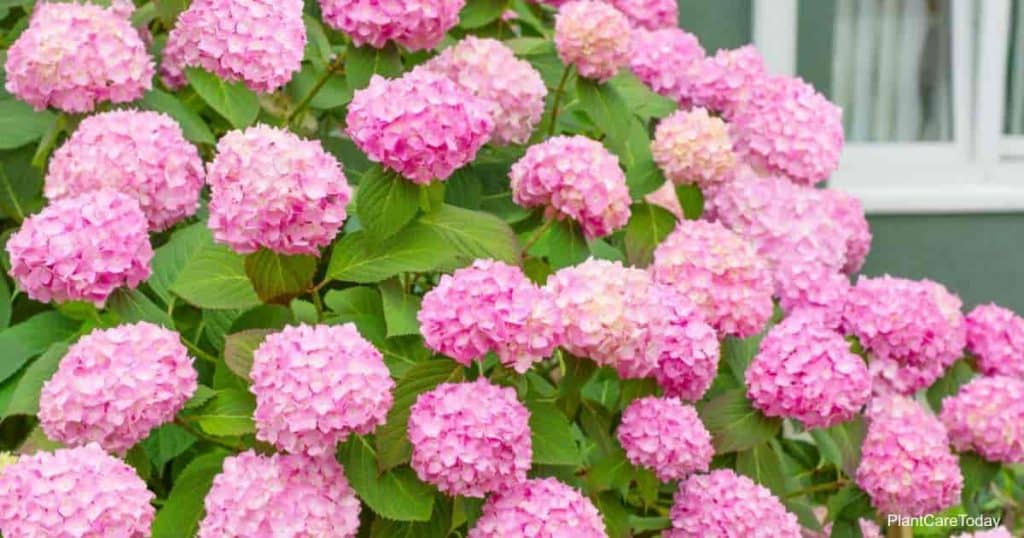Many gardeners find themselves frustrated by hydrangeas not blooming. What are the reasons for this, and what can you do?
You may be surprised to learn your problem may be as simple as the wrong type of hydrangea or the wrong type of pruning.

In this article, we share advice on choosing the right hydrangea for your setting and pruning it correctly to produce the most blooms. Read on to learn more.
The Four Types of Hydrangeas You Should Know
Knowing what kind of hydrangea you have can help answer the question, “Why is my hydrangea not flowering?”
Hydrangea Paniculata Grandiflora: The Tree Or Peegee Hydrangea
Over pruning can cause a lack of buds, and one reason you might be over-pruning your hydrangeas is hydrangea bushes are typically quite wide and need a lot of space.
If this is the case in your garden, you may wish to choose a tree form of hydrangea, such as Hydrangea paniculata.
This tall, slim type of hydrangea blooms on new wood in the springtime, so it naturally takes up less space.
Trim it back to suit your space without sacrificing blossoms.
Native Hydrangea Arborescens Are Easy Bloomers
One foolproof way to get lots of blooms is to try planting native hydrangeas such as Annabelle or Hills of Snow. These are both Hydrangea arborescens.
They are winter hardy even in the coldest USDA hardiness zones, and they produce lots of attractive white flowers maturing to a lovely shade of green.
Related: Why Are My White Hydrangeas Turning Green?
Prune these hardy natives anytime you like from late autumn through summer and into the springtime.
Hydrangea Quercifolia: Oakleaf Hydrangea
Hydrangea quercifolia is another very stunning native hydrangea producing incredibly showy, large flowers.
This type of hydrangea is also known as Oakleaf hydrangea because, in addition to its big, white, and pink blooms, it also has large leaves resembling oak leaves, providing a great deal of autumn and winter interest.
Hydrangea quercifolia’s big, pretty, pink blooms are exceptionally good for use as dry flowers.
In the wintertime, after the flowers and leaves have fallen, the rough bark of the plant provides winter interest.
Hydrangea Macrophylla Is A Florist’s Hydrangea
If you received your hydrangea as a potted plant wrapped in plastic or foil, it’s very likely you have a florist’s hydrangea.
It is also very likely this hydrangea is not winter hardy in your setting.
Alternately, it may be winter hardy, but it may also need some time to settle in and develop some woody growth.
When you plant a gift hydrangea outdoors, be prepared to wait at least a couple of years for blooms to appear.
Hydrangea macrophylla usually bloom on old wood.
This is wood which developed and produced some flower buds in the prior year.
This old wood and its buds are damaged by extremely cold temperatures, so in very cold settings, you may never see flowers from florist’s hydrangeas.
If you live in a fairly temperate setting where your hydrangea macrophylla is winter hardy, you may have problems with blooming because you are pruning incorrectly or because deer are eating your hydrangeas.
If you cut these plants back in the autumn, in preparation for winter, you’ll be cutting away the buds becoming flowers in the spring.
Likewise, if hungry deer eat your hydrangeas late in the autumn and into winter, they will prune away the buds.
If you specifically want plant hydrangea macrophylla, get more buds and more flowers by choosing some of the newer cultivars such as Endless Summer or Let’s Dance.
These are reblooming hydrangeas which bloom early in the springtime on old wood and again later in the summer on new wood.
With these choices, even if you do prune a little bit too enthusiastically or do have wild visitors nibbling your garden, you will have blooms on your hydrangeas at some point during the growing season.
What If You Just Can’t Get Your Hydrangeas to Bloom?
If you’ve tried all these tips, or if you have hydrangeas which bloomed in the past but have stopped, you may have a problem with overcrowding and/or impoverished soil.
If plants become overcrowded, thin and divide them early in the springtime.
Refresh the soil with amendments of organic compost.
Remember to apply a good quality, slow-release granular fertilizer during the springtime or early in the summer.
Fertilizers with a higher percentage of phosphorus (the “P” in the NPK rating) will stimulate more blooms.
If all else fails, keep in mind hydrangeas all have lovely foliage, and even without flowers, they make an excellent hedge or privacy screen.
Recommended Reading
